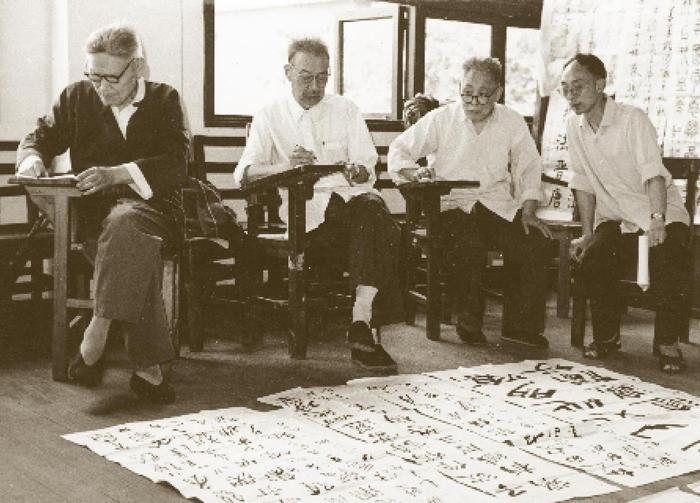是書家更是學者
劉楊

2020年是沙孟海誕辰120周年。為了紀念沙孟海為中國書法事業作出的卓越貢獻,研究其學術理念和方法,弘揚其藝術精神,追尋一代藝術巨匠和高等書法教育先驅的風范,“碧血丹心——紀念沙孟海誕辰120周年系列活動”于2020年11月底舉行。
一
紀念活動分為三個板塊:沙孟海書法篆刻藝術大展暨學術文獻展;傳承、跨越與典范:紀念沙孟海誕辰120周年座談會;全國“書法學”學科建設與發展學術研討會。其中,沙孟海書法篆刻藝術大展暨學術文獻展于11月28日在北京中國美術館開展。
這次展出,反復甄選了沙孟海先生各個時期最具代表性之書法、篆刻作品以及文獻、遺物300余件(組),其中不乏首次面世的珍貴手稿。
展覽分“翰墨千秋”“金石永壽”“積健為雄”“百年樹人”四個板塊,彰顯先生窮源竟流、精益求精的治學態度,臨池不輟、厚積薄發的藝術精神,投身文博、書法教育事業的滿腔熱情,及其對中華民族文化自強的堅定信念,全方位地展示沙孟海先生作為文人學者的崇高理想、作為藝術家的卓越成就、作為教育家的時代擔當。
二
沙孟海(1900~1992年),原名文若,字孟海,號石荒、沙村、決明。出生于浙江鄞縣(今浙江省寧波市鄞州區),曾任浙江大學中文系教授、浙江美術學院(現中國美術學院)終身教授、西泠印社社長、西泠書畫院院長、浙江省博物館名譽館長、中國書法家協會副主席等職。
沙孟海先生是中國高等書法教育的先驅。20世紀60年代初,沙孟海應潘天壽之邀,與陸維釗等諸位先生在浙江美術學院(現中國美術學院)籌辦并成立了全國首個書法專業。此舉開創了書法的高等教育之路,于現代學院體系中重新建立起了道藝會通、學養相成的書法教育“通人之學”。
中國美術學院的書法教育,自1963年至今,不僅代表著中國高等書法教育的發展歷程、發展方向,亦勾勒出學科建設、教學設置、人才培養的基本框架與前景規劃,開辟了中國高等書法教育和當代書法發展的嶄新格局。直至今日,全國已有200余所高校開設有書法專業。
回溯這超過半個世紀的漫漫長路,“敢為天下先”的開拓精神和“含弘光大”的責任擔當,始終貫穿在書法專業各時期的發展之中,體現在一代代師生教學的點滴之間,是高等書法教育得以不斷發展和完善的不竭動力與源泉。
而高等書法教育之開創,不僅依靠著前輩們的責任感與使命感,更離不開他們嚴謹的治學態度與卓絕的學術眼光——沙孟海先生認為:“作為一個書法家,一方面要了解文字的結構和書體源流,借鑒名跡,熔鑄古今,推陳出新,自成風貌。另一方面還得轉益多師,要有字外功夫,諸如文學、文字學、史學、哲學等學問修養,更要有崇高的人格修養。”
雖然當時書法專業尚處草創期,書法學科遠未成型,但他們高瞻遠矚,對整個書法學科與教育的發展,以及相關問題都有著超越時代的遠見卓識。
三
沙孟海先生被稱為“20世紀書壇泰斗”,在書法篆刻藝術上取得了極為輝煌的成就。于書,則化古融今,自成一格,尤其是擘窠大字,有“海內榜書第一”之譽;于印,則清逸醇正,入古出新,所作古璽、漢印到明清流派,甚至隸楷入印,皆能信手拈來,又極富書卷之氣。
沙孟海更是學者,其一生潛心治學、成果頗豐,于金石學、文字學、古器物學、語言學、考古學、博物館學諸領域均深有研究;沙孟海在同代學人中,較早地引入近代考古學視野,對傳統金石學進行反思,批評沒有宏觀視野與系統框架的文獻搜輯與材料羅織;與羅振玉一樣,他也主張改金石學為古器物學。沙先生早期的考碑之作以及諸多文獻考證,可謂將書法與考古融為一體之實踐,文獻爬梳之外,自有其史學之目的與見解。他在史學方面的構建與疏通工作,乃書法之學會通經史、連接古今的一個重要象征。
Toward the end of November, a series of events was launched in commemoration of 120th anniversary of Sha Menghai (1900-1992), an accomplished calligrapher and scholar based in Hangzhou. The events were in three parts. The first was a large-scale exhibition of Shas calligraphy and seal engraving and documents about his artistic brilliance at the National Art Museum of China in Beijing. The exhibition went from November 28 to December 6 showing over 300 exhibits from various heavyweight art and education institutions of Zhejiang. After the opening ceremony of the exhibition, a memorial meeting was held in commemoration of the great calligrapher. Attendees at the seminar reminisced about Shas life and achievement.
The second event was an academic seminar in commemoration of the calligrapher. The third event was an academic seminar about issues in college-level calligraphy education in
Sha Menghai, a native of Yinxian County in eastern Zhejiang, is a key chapter in the 20th-century history of calligraphy in China. He worked as a professor of the Chinese Department of Zhejiang University and tenured professor of Zhejiang Academy of Fine Arts, the predecessor of present-day China Academy of Art; he was president of Xiling Seal Art Society and president of Xinling Academy of Calligraphy and Art, honorary curator of Zhejiang Museum, and vice president of China Calligraphers Association.
Sha was a pioneer in calligraphy education at college level across the nation. In 1963, Sha Menghai and Lu Weizhao set up the calligraphy major at Zhejiang Academy of Fine Arts. It was the first of its kind in China. Thanks to Sha and Lu, calligraphy is now a very successful and mature major at over 200 higher education institutions of China, carrying on the art of traditional calligraphy, which was almost as old as the Chinese civilization, to the future
Sha was engaged to be one of the two founders of the calligraphy studies at the academy for good reasons. An innovative calligrapher of the 20th century, he was a prominent scholar of various fields of calligraphy and was the number one calligrapher who wrote huge-size Chinese characters unlike anyone else of his time. In particular, he was accomplished in the fields of ancient inscriptions on metal and stone, Chinese philology and linguistics, archaeology and museology. He wrote and published a series of books on calligraphy.
Sha contributed a great deal to calligraphy education at college level. He took it as a mission to carry on calligraphy as a tradition.
“As a calligrapher, one needs to understand philology and linguistics, and understand where all the changes in calligraphy came from. In calligraphy education, the past and the present and the future need to be one. Whats new must come from whats old. Calligraphers get to establish their own styles and break away from stereotypes. On the other hand, one needs to study literature, literary style, history, philosophy in order to be a good calligrapher and a good person,” remarked the master about his insight and foresight into calligraphy.
A founder of the calligraphy studies at Zhejiang Academy of Fine Arts, Sha brought his vision to the education course in 1963. His vision still serves as a guideline for college-level calligraphy studies in China.

